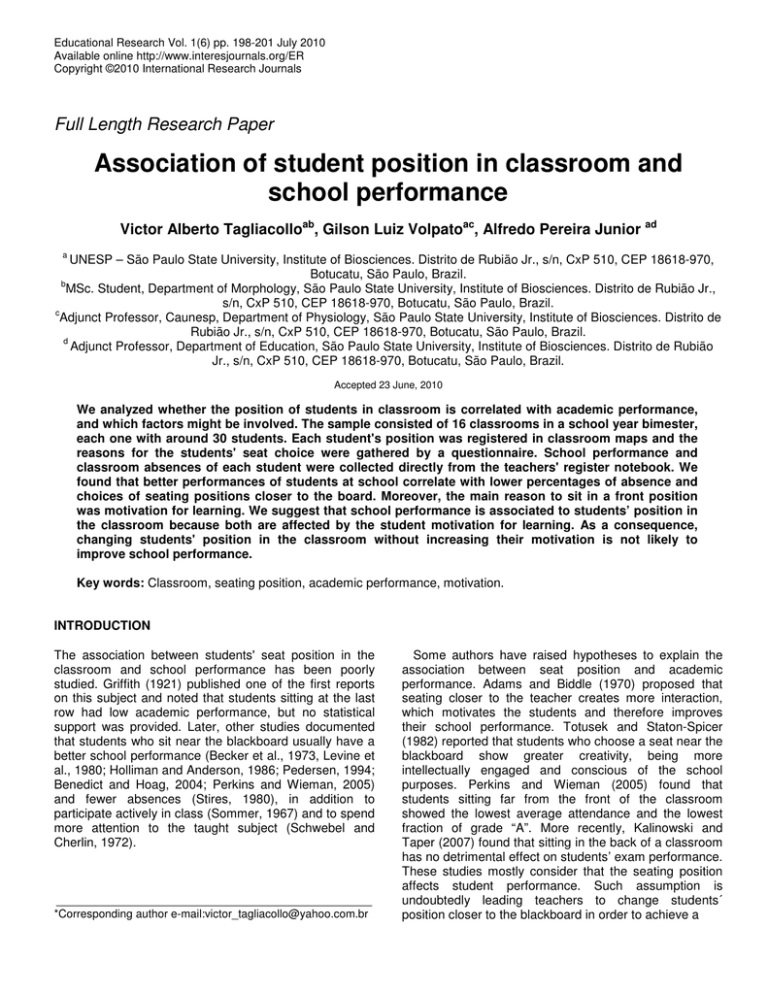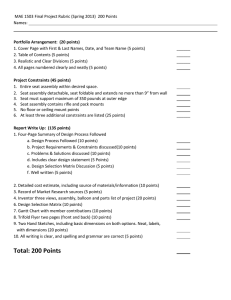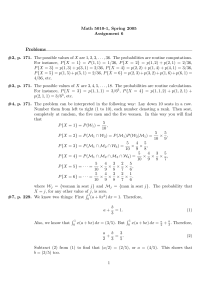Document 14093270
advertisement

Educational Research Vol. 1(6) pp. 198-201 July 2010 Available online http://www.interesjournals.org/ER Copyright ©2010 International Research Journals Full Length Research Paper Association of student position in classroom and school performance Victor Alberto Tagliacolloab, Gilson Luiz Volpatoac, Alfredo Pereira Junior ad a UNESP – São Paulo State University, Institute of Biosciences. Distrito de Rubião Jr., s/n, CxP 510, CEP 18618-970, Botucatu, São Paulo, Brazil. b MSc. Student, Department of Morphology, São Paulo State University, Institute of Biosciences. Distrito de Rubião Jr., s/n, CxP 510, CEP 18618-970, Botucatu, São Paulo, Brazil. c Adjunct Professor, Caunesp, Department of Physiology, São Paulo State University, Institute of Biosciences. Distrito de Rubião Jr., s/n, CxP 510, CEP 18618-970, Botucatu, São Paulo, Brazil. d Adjunct Professor, Department of Education, São Paulo State University, Institute of Biosciences. Distrito de Rubião Jr., s/n, CxP 510, CEP 18618-970, Botucatu, São Paulo, Brazil. Accepted 23 June, 2010 We analyzed whether the position of students in classroom is correlated with academic performance, and which factors might be involved. The sample consisted of 16 classrooms in a school year bimester, each one with around 30 students. Each student's position was registered in classroom maps and the reasons for the students' seat choice were gathered by a questionnaire. School performance and classroom absences of each student were collected directly from the teachers' register notebook. We found that better performances of students at school correlate with lower percentages of absence and choices of seating positions closer to the board. Moreover, the main reason to sit in a front position was motivation for learning. We suggest that school performance is associated to students’ position in the classroom because both are affected by the student motivation for learning. As a consequence, changing students' position in the classroom without increasing their motivation is not likely to improve school performance. Key words: Classroom, seating position, academic performance, motivation. INTRODUCTION The association between students' seat position in the classroom and school performance has been poorly studied. Griffith (1921) published one of the first reports on this subject and noted that students sitting at the last row had low academic performance, but no statistical support was provided. Later, other studies documented that students who sit near the blackboard usually have a better school performance (Becker et al., 1973, Levine et al., 1980; Holliman and Anderson, 1986; Pedersen, 1994; Benedict and Hoag, 2004; Perkins and Wieman, 2005) and fewer absences (Stires, 1980), in addition to participate actively in class (Sommer, 1967) and to spend more attention to the taught subject (Schwebel and Cherlin, 1972). *Corresponding author e-mail:victor_tagliacollo@yahoo.com.br Some authors have raised hypotheses to explain the association between seat position and academic performance. Adams and Biddle (1970) proposed that seating closer to the teacher creates more interaction, which motivates the students and therefore improves their school performance. Totusek and Staton-Spicer (1982) reported that students who choose a seat near the blackboard show greater creativity, being more intellectually engaged and conscious of the school purposes. Perkins and Wieman (2005) found that students sitting far from the front of the classroom showed the lowest average attendance and the lowest fraction of grade “A”. More recently, Kalinowski and Taper (2007) found that sitting in the back of a classroom has no detrimental effect on students’ exam performance. These studies mostly consider that the seating position affects student performance. Such assumption is undoubtedly leading teachers to change students´ position closer to the blackboard in order to achieve a Tagliacollo et al. 199 better performance. However, such assumption might not be valid. A clear association between seat position and school performance does not necessarily imply a cause-andeffect relationship. If seat position affects school performance, then changing students from their seat should affect their school performance. However, student motivation for learning might determinate both seating position and school performance. In this way, no causal effect occurs between seat position and school performance and thus changing position should not have any significant effect on students´ performance. Weinstein (1985) and Grump (1987) reported that personality and behavior of the students influence the choice of seat. Although the seat position can motivate, or disincentive the student for learning, students´ interest for learning may also affect the position they choose in the classroom. Moreover, studies on these topics conducted on elementary school level of underdeveloped countries are still scarce and no paper has been published about Brazilian students yet. Would these students react differently than the population already studied? If motivation for learning is an important factor on this issue, socio-economic condition of the country might also be considered. Here we analyzed whether positioning of young students in the classroom is associated with academic performance, as well as diagnose factors involved in such association. This study was carried out in classes of Brazilian public schools. METHODOLOGY Study strategy We looked for association between the students´ seat position and their school performance (as measured by the mean grade at the end of the semester and percentage of absence). In a second step, students answered a questionnaire to investigate factors involved in their seat choice and school performance. Characterization This research investigated 16 classes of 2 elementary public schools (with a total of 194 and 304 students) in Botucatu, SP, Brazil, during a school year bimester. These classrooms had only one board located at the front of the room where the teacher stays most of the time. The grade levels represented uniformly the last four years of Brazilian basic education and the ages of the students ranged between 11 to 16 years old, because some of them failed one year or started the studies later. The students always stayed in the same classroom and had free choice about where to sit. Students’ position Class size averaged 31.12 ± 3.95 students for a total of 498 distributed in seats disposed in 6 rows (from front to back) and 6 columns. Each classroom was randomly visited at least 5 times, one visit each two weeks, without previous notice. In each visit we registered the seat position of each student on the respective classroom map. Students were individually identified so that position considered only students remaining in the same seat position at least 3 to 5 visits because some of them were absent; the others were considered erratic students and represented 17.67% (88 students) of the total sample and were not included for statistical analyses. The position of the students considered for analysis (82.33% of the sample; 410 students) was divided as follows: a) often sit in front (rows 1 and 2); b) often sit in the middle (rows 3 and 4); c) often sit at the rear (rows 5 and 6). School performance and percentage of absence We registered students’ grade and calculated their average, as well as their respective percentage of absence for the school year bimester. These annotations were obtained directly from the teacher´s register notebook. Factors involved in seat choice and school performance Individuals from 16 classes responded a questionnaire to find reasons for seat choice and school performance. Because not all students could be contacted, this sample included 427 students. This survey was conducted after the 5 visits to the schools to register the students’ positions in classroom. The questionnaire consisted of two multiple choice questions, where they had to choose only one answer for each question. One question asked about the position where the student sits mostly in the classroom [a) sit in front; b) sit in the middle; c) sit at the rear; d) sit in any place]. The other question addressed the reason why they choose the seat at the classroom, and included the following possibilities: a) I like to study, I can learn better and pay more attention in the class; b) I prefer to stay together with my friends; c) it is the best place to talk to and have fun with my friends; d) the teachers speak softly or because I cannot read at the blackboard; e) I like the teachers; f) I do not like to talk and prefer to stay quiet; and g) none of the above. These questions were considered in the following traits: a) motivation for learning; b) friendship; c) friendship with no learning motivation; d) physical needs; e) affection to the teachers; f) social isolation g) other choice. The first question was contrasted with the classroom map to check for data validity. The second question of the valid data was then contrasted with the seat choice. Statistics For statistical analysis of students´ school performance and absence percent we used ANOVA with 3 factors (students’ position, students’ grade and students’ absence), followed by a Tukey test, specifically Honestly Significant Difference Test (HSD) (Zar, 1996). For questionnaire statistical analyzes, we compared frequencies of answers among students’ seat position for each answer (7 alternatives x 3 seat positions) by Goodman’s test (Goodman, 1965). The samples of seat position were adjusted and no levels or institution were considered here because in the seat position tests these variables showed no effect at all. For the statistical analysis, the level of significance was set at 0.05. 200 Educ. Res. A - School performance 8 FRONT 4 2 0 Front BACK Middle b b Back 24 Motivation for learning B - Absence b c (answer A) Student's absence (%) MIDDLE 6 Number of students Student's grade (%) 10 (answer B) (answer F) Friendship Social isolation 21 18 Figure 2. Students’ reasons to choose a seat position in elementary school. Values with at least one same letter do not differ among themselves in the same answer (Goodman test; N=386 students). 15 12 9 6 isolation (Figure 2). 3 0 Front Middle Back Figure 1. Student performance in elementary school according to seat position. Mean values (+s.d.; N = 410 students) compared by ANOVA and followed by Tukey’s test. Asterisks indicate difference respective to the other means (p < 0.05). RESULTS We found a significant association between students´ position and both school performance and absence. Accordingly, students who sit far from the board had lower school performance (Figure 1A) and higher percentage of absence (Figure 1B); the best performances (grade and presence) were more frequent for students who sit at the front position (Figure 1). From the questionnaire, only a few students (9.60 %; 41 students) did not choose a fixed seat at the school and were not considered in this survey. The others (90.4%; 386) are shown in Figure 2 (contrasting questions 1 and 2).Students’ reason to choose a seat was associated with seat position. Students sitting in the front position mostly declared motivation for learning as a main reason to choose a seat; on the other hand, friendship was most important for those at the middle rows and the back position was associated to social DISCUSSION Association between students’ school performance and choice for a seat position was already described a few decades ago (Becker et al., 1973; Levine et al., 1980; Stires et al., 1980; Holliman and Anderson, 1986). More recently, authors have stressed an effect of seat position on students’ school performance. Accordingly, students at the front position have more probability to reach the highest grade (Benedict and Hoang, 2004) and seat position significantly affects absence to classes and grades (Perkins and Wieman, 2005). Although Kalinowski and Taper (2007) asserts a non causal relationship between seat position and student performance, they still assume that this might depend on the classroom size (thus accepting effect of position on learning). Whenever a detrimental effect on learning is detected, educators are impelled to abolish, or minimize, the cause to improve learning. If such cause and effect relation is not valid, changing the supposed cause (seat position) results in no effect on learning, thus proving a failed technique. Here, we showed that seating distance to the blackboard is inversely correlated with school grade performance and directly associated with percentage of absence of the student. These associations, however, are shown here as an effect of a third component, the motivation for learning. Such a motivation is an important factor determining both seat position and school performance, thus explaining why these two effects are Tagliacollo et al. 201 associated with each other. If so, changing students’ seat to a front position should be ineffective or little effective, to improve learning. While students at the front rows obtained the highest grades and were mostly present in classes, our study included an analysis on students’ reasons for choosing a seat at the class. Such an analysis revealed that students at the front position are significantly more motivated for learning and the other main reasons are friendship and social isolation. A parsimonious conclusion is that a students’ motivation is the driving force behind seat choice: learning-motivated students prefer be closer to the teacher, while those most concerned with social relationships stay faraway physically and mentally. Mercincavage and Brooks (1990) discussed motivation and reported its influence on seat choice, and Adams and Biddle (1970) proposed that proximity of the teacher creates more interaction, which motivates the students and therefore improves their school performance. Kallinowski and Taper (2007) also reinforce motivation to explain why seat location and school performance were not associated with each other in major students in a small biology class, a condition where all students are expected to be involved in the class. They contrast this with Perkins and Wieman´s (2005) study, who found such association in physics nonmajor students at a larger class, where motivation in some students and seat at a front position should have great influence on school performance, thus forcing the association. Our study could more certainly investigate this debate by the questionnaire survey. This query demonstrated that motivation and interest in learning are the common factors that condition the students’ seat choice as well as their school performance (Figure 2). Although these data do not eliminate that seat position affect learning performance, we emphasize that motivation is an important factor. We should also consider that our study was developed in students before the high school level in a country where motivation for learning in public school is minimal. Thus, some motivated students have no choice for learning except sitting closer to the teacher, revealing that motivation for learning is a predominant factor for school performance than seat position (this is only a passive consequence, a way to the motivated student reach the goal of learning). This conclusion implies caution for pedagogic practices of changing students’ position to reach a better school performance. It seems more important for the teacher to look for ways to increase motivation of students for learning, and thus they are expected to be more involved in the class so that seat position association can be minimized. CONCLUSION We conclude that students’ motivation for learning determines concomitantly students’ seat choice and school performance. This effect explains why seat position is associated with school performance. Therefore, we suggest that displacing student to a frontal seat position in the classroom to improve learning performance is probably not a desirable alternative; instead, the teacher should consider raising the students’ motivation. REFERENCES Adams RS, Biddle BJ (1970). Realities of teaching: Explorations with the video tape. New York: Holt, Rinehart & Winston. Pp. 110. Becker FD, Sommer RJ, Oxley B (1973). College classroom ecology. Sociometry. 36:514-525. Benedict ME, Hoag J (2004). Seating location in large lectures: Are seating preferences or location related to course performance? J. Econ. Educ. 35: 215-231. Goodman LA (1965). On simultaneous confidence intervals for multinomial proportions. Techometrics, Alexandria. 7:247-254 Griffith CR (1921). A comment uppon the psychology of audience. Psychol. Monogr. 30:36-47. Grump P (1987). School and classroom environments. In D. Stokols & I. Altman (eds.). Handbook of environmental psychology. New York: Wiley. Pp. 698-701 Holliman WB, Anderson HN (1986). Proximity and student density as ecological variables in a college classroom. Teach. Psychol. 13:200203. Levine DW, O´Neal EC, Garwood SG, McDonald PJ (1980). Classroom ecology: The effects of seating position on grades and participation. Pers. Soc. Psychol. Bull. 6: 409-412. Kalinowski S, Taper ML (2007). The effect of seat location on exam grades and student perceptions in an introductory biology class. J. Coll. Sci. Teach. 36: 54-57. Mercincavage JE, Brooks CI (1990). Differences in achievement motivation of college business major as a function of year in college and classroom seating position. Psychol. Rep. 66:632-634. Pedersen DM (1994). Personality and classroom seating. Percept. Motor Skill. 33:1355-1360. Perkins KK, Wieman C (2005). The surprising impact of seat location on student performance. The Physic. Teach. 43:30-33. Schwebel AI, Cherlin DL (1972). Physical and social distancing in teacher-pupil relationships. J. Educ. Psychol. 63:543-550. Sommer R (1967). Classroom ecology. J. Appl. Behav. Sci. 3:489-503. Stires L (1980). Classroom seating location, student grades, and attitudes: Environment or self-selection. Environ. Behav. 12:241-254. Totusek P, Staton-Spicer A (1982). Classroom seating preference as a function of student personality. J. Exp. Educ. 505: 159-163. Weinstein CS (1985). Seating arrangements in the classroom. International Encyclopedia of Education. New York: Pergamon. Zar JH (1996). Biostatistical analysis (3rd ed) New Jersey: Prentice Hall. Pp. 718.





